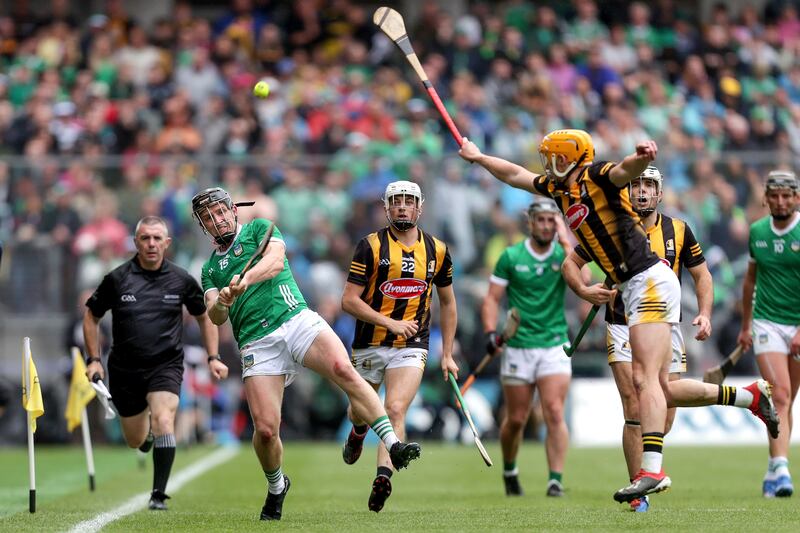For easy consumption, we’re inclined to look for the essence of teams. Something that you can stick a fork into and that won’t take up the whole plate: a score, a passage of play, an episode of defiance. Limerick offer you that menu, if you wish.
In the 19 points they racked up after Paddy Deegan’s goal you will find points that involved five passes in the build-up (three times); scores from turnovers (five times); scores that originated directly from the opposition puck-out (eight times); points from outrageous locations near the sideline (five times).
You can stick a needle into the bloodstream of any of those scores and the result of the lab tests will confirm what you already knew. No other team tackles better than they do; no other team can absorb such physical hardship and be in a fit state to give it back, with interest; no other team has such a variety of shooters, or such propensity to shoot from distance; no other team minds the ball with such nimbleness, whether they find themselves in briars or in the clear.
The essence of them, though, is what all of that stuff adds up to: the pulverising capacity to blow teams away, to make them forget everything they thought they knew about winning. To wipe their hard drive.
READ MORE
Kilkenny suffered as a host of others had done before them. They led by six points 10 minutes before half-time and lost by nine, precisely as Galway had done in the semi-final. Tipperary led by 10 at half-time in the 2021 Munster final, and lost by five. Cork were just a point down after 13 minutes of the 2021 All-Ireland final and trailed by 13 points at the break.
Limerick have this spectacular capacity to overwhelm opponents in a comparatively short space of time, extinguishing all mystery about the outcome in the process.
There were differences about last Sunday. Before Deegan opened the scoring, the last time Limerick had trailed in an All-Ireland final was at 3.46pm, on August 19th, 2018. Galway’s lead lasted less than a minute. On Sunday, Limerick trailed for about 42 minutes out of the first 50, none of which was against the balance of play.
That has been a pattern in their performances this year: they have allowed teams into the game. The only championship match in which they took command early on was against Waterford, but they had surrendered that control by the final quarter. They trailed at half-time against Kilkenny, Galway, Clare (in the Munster final) and Tipperary, and were only level at the break against Cork.
During the Munster championship, that seemed to suggest a degree of slippage. There was no significant changes to their on-field set-up or their line-up, and it looked like holes were appearing in their aura. Had teams worked them out a bit? Had Limerick lost some of their potency or desire? So, what do we say now? The last half an hour on Sunday was probably the greatest spell of hurling this team has ever produced.
Comparisons with the four-in-a-row Kilkenny team of 2006-2009 are unavoidable and maybe invidious. That Kilkenny team reached their peak in 2008, probably in the first half of that year’s All-Ireland against Waterford when they scored 2-15 from just 19 attempts on goal, and didn’t have a wide until first half stoppage time.
When Limerick blew Cork away in the first half of the 2021 All-Ireland final, making a direct comparison with Kilkenny in 2008 had a superficial validity at least. Limerick racked up 3-17 in that first half, at a cost of just five wides – which was an impressively small number of misses for a team with so few inhibitions about shooting on sight.
The 3-30 that Kilkenny scored against Waterford in 2008 was a record in an All-Ireland final, a standard that stood until Limerick scored 3-32 13 years later. But allowing for the sharp inflation in scoring totals over the last decade, isn’t there a case that Kilkenny’s total is still more impressive?

How would you make a comparison stand up? The current Limerick team are the best passers of the ball hurling has ever seen, but that wasn’t even a consideration for the Kilkenny four-in-a-row team. They built their empire on dominating contested ball in every sector of the pitch. That was the game.
For the second time in their four-in-a-row, Limerick failed to score a goal in the All-Ireland final; in 2020 they won the All-Ireland despite failing to score a goal in four games out of five. On Sunday, they didn’t even force Eoin Murphy to make a save. Kilkenny’s attitude to goals was wildly different. In 2008 they averaged nearly three goals a game; a year later they scored two in every game.
The emphasis on the collective over the individual was a sworn article of faith for Brian Cody’s Kilkenny teams, and for this group of Limerick players it is not different. And yet, within that overarching code, there was scope for individuals to flourish.
On Sunday, Cian Lynch made a glorious return to his best form. In the first half, when Limerick scored just nine times, Lynch had a direct involvement in six of them. Diarmaid Byrnes gave another masterful exhibition of long range shooting, finishing the game as top scorer, surely a unique achievement for a wing back in an All-Ireland final.
Earlier this year he became the highest scoring defender in the history of the championship, and wherever his finally tally comes to rest, those numbers will stand alone for decades.
Have they reached their ceiling yet? Could they win another All-Ireland, or two, by simply managing their decline, as the Dublin footballers did. The only breakthrough player in their starting 15 this year was 30-year-old David Reidy, but the average of the team is still under 28. They have time yet.
They won’t waste it.




















